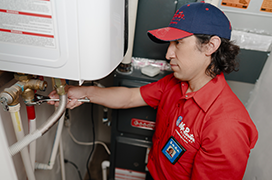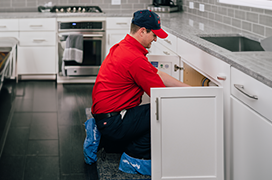A routine plumbing inspection from our plumber will allow for maintenance on your plumbing fixtures, for example, your hot water tank. Typical issues with tank-based units include sediment residue at the bottom, faulty pilot lights on tank-based units, and strange noises from rumbling to whistling. Of course, this is all made worse without regularly flushing your unit, which can lead to rust buildup, clogs, and even frozen pipes. Overall, routine cleaning of a water tank should be completed every couple of years to keep your hot water heater repair services to a minimum.
Our skilled plumber will perform flushing and sediment deposit removal. The cleaning process takes no more than one hour to complete and is always followed by a full diagnosis and inspection to ensure your hot water is flowing freely. A regular tank cleaning can be paired with a plumbing inspection and diagnosis in Burnabyto prevent any plumbing problems. However, the last thing you need is to be tapped out of hot water during a freezing winter season. A new Burnabywater heater installation with extra features sounds just about right! We’ll also go the extra mile to insulate the tank for you with a water heater blanket!
Our BurnabyWater Heater Installation Services
Don’t wait until your unit kicks the bucket and you’ve drained every ounce of precious hot water–be proactive and ask us about a wide range of options for a Burnabywater heater installation. Sometimes going for a brand-new replacement rather than refurbishing your old unit is more budget-friendly in the long run as you avoid repetitive and ineffective repairs. If you’re seeing red flags of a deteriorating unit, for example, red rusty coloured water, random puddles around the tank, fluctuating pressure, strange noises, odd odours, corrosion on the tank, or tepid water streaming from the tap you know something is fishy.
Types Of Water Heater Installation: Electric & Gas
The most popular units are either natural gas or electric. An electric water heater operates by transferring cold water to the dip tube and heats it using thermal energy inside of the tank, and as this takes place, the hot water slowly rises in the tank and floods throughout the home’s drainage lines through the heat-out pipe. Although it’s slower to kick start hot water flow and is the more expensive option compared to its gas counterpart in the long run, it’s the more energy-efficient and sustainable option as the heating rods are submerged inside the water of the sealed tank, so there is less heat loss overall. Routine maintenance is also required less often as gas units easily deteriorate without proper upkeep. On the other hand, gas-powered systems are still widely used and considered fast-operating and highly efficient. But, of course, it can drain your wallet over time. Periodic maintenance is important and should include checking for gas line leaks.
Pilot Light
If you are aiming to install a tank-based unit, the last thing you need is for your pilot light to be snuffed out during the frigid, snowy season, leaving you all tapped out for hot water. The pilot light on a unit is a small flame that must remain lit to ensure long-lasting heat, and although it can be serviced by your local utility company's emergency hotline if it flickers out, many on-call technicians are usually backlogged and will eventually grow weary of you crying wolf.
It’s best to be responsible and get a functional light attached during your Burnabywater heater installation. Our expert technician opts for a standing pilot light that acts as the primary source of heat for your plumbing system and provides the voltage juice required for the gas valve to operate smoothly. Or they will go for an intermittent pilot ignition (IPI) that doesn’t require an actual flame to work but uses an electrode circuit to spark the pilot light, so the burners can ignite, as the burners are directly tied to the pilot light remaining lit. The type of pilot light you receive will depend, of course, on your type of unit, as a standing pilot light is suitable for a gas-powered water heater, while an IPI best serves an electric-powered water heater.



